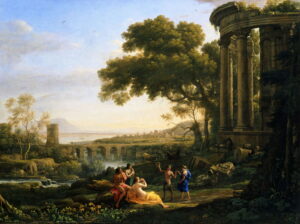Almost an Impressionist: Commemorating the death of Jean-François Raffaëlli 1

The history of painting is often completely arbitrary over who is remembered. Claude Monet is today viewed as the leading French Impressionist, and Edgar Degas as a member of the same movement, even if he was the odd man out. Yet Jean-François Raffaëlli, who exhibited in two of their exhibitions, has almost been forgotten, and is hardly ever included as an Impressionist. As he died a century ago tomorrow, on 11 February 1924, this weekend I commemorate his life and art in two articles, today’s showing a selection of his paintings up to 1886.
Around 1880, Raffaëlli became one of the frequent points of friction between Degas and most of the other French Impressionists, and Raffaëlli’s dominance with thirty-seven works in the fifth Impressionist Exhibition of 1880 drove Monet to withdraw from it altogether. The following year, Raffaëlli exhibited again, so Monet didn’t. It was only in the seventh Impressionist Exhibition of 1882 that Monet returned, and both Degas and Raffaëlli withdrew. This resentment is reflected in Monet’s bitter complaint that the exhibition had “become a commonplace school which opens its doors to the first dauber to come along.” There was clearly no love lost between Monet and Raffaëlli.
Raffaëlli was born in Paris in 1850, and as his name suggests was of Italian descent. He started to paint seriously in 1870 when he had a landscape painting accepted for that year’s Salon. The following year he undertook just three months of study under Jean-Léon Gérôme, which formed his only training.
Jean-François Raffaëlli (1850-1924), The Ragpicker (1879), oil on panel, 77 × 69 cm, location not known. Wikimedia Commons.
During the mid-1870s, Raffaëlli started painting the poorer residents of Paris and its surrounds. The Ragpicker from 1879 was a great success, and his work was promoted by the influential critic Joris-Karl Huysmans. At about this time, he joined Degas’ circle, and the latter helped his career and repeatedly tried to bring him into the Impressionist movement and its exhibitions.
Jean-François Raffaëlli (1850-1924), Man with Two Loaves of Bread (1879), further details not known. Wikimedia Commons.
Man with Two Loaves of Bread (1879) is another of his social realist paintings. His bowed head and furtive look make you wonder just how he had acquired those loaves.
Jean-François Raffaëlli (1850–1924), Garlic Seller (c 1880), media not known, 71.8 x 48.9 cm, Museum of Fine Arts Boston, Boston, MA. Wikimedia Commons.
This elderly Garlic Seller from about 1880 is making his way across a muddy field just beyond one of the new industrial areas on the outskirts of Paris, his battered old wickerwork basket containing the garlic he hoped to sell. Behind him is his companion, a dog.
Jean-François Raffaëlli (1850–1924), Afternoon Tea (c 1880), media not known, 34.9 x 28.6 cm, Art Institute of Chicago, Chicago, IL. Wikimedia Commons.
Although not as overtly poor, this couple taking Afternoon Tea (c 1880) are also living at the edge of society, this time with a cat keeping watch between their potted plants on the windowsill.
Jean-François Raffaëlli (1850-1924), The Absinthe Drinkers (c 1880-81), further details not known. Wikimedia Commons.
In The Absinthe Drinkers (c 1880-81) Raffaëlli followed from Manet’s first major painting of about 1859, and a theme that Degas had also painted in 1875-76. Degas’ version had met with a hostile reception, and at this time was being stored.
Raffaëlli had threatened to overwhelm the work of the ‘real’ Impressionists at their exhibition in 1880, when he showed thirty-seven, and forced Monet to withdraw in response. Raffaëlli’s The Absinthe Drinkers was shown at the sixth Impressionist Exhibition the following year, when it was one of the few works to attract critical approval.
Jean-François Raffaëlli (1850-1924), Guests Waiting for the Wedding (before 1884), oil on panel, 52.5 x 68.5 cm, Musée d’Orsay, Paris. Wikimedia Commons.
Guests Waiting for the Wedding from before 1884 also seems to have been well-received. This pair are stood outside an official wedding room that has, like them, seen better days.
Jean-François Raffaëlli (1850-1924), Sailors from the North (date not known), oil on wood, 68 x 53 cm, Nationalmuseum, Stockholm, Sweden. Wikimedia Commons.
Raffaëlli’s undated Sailors from the North shows a discussion taking place in the midst of a tangle of rigging of sailing vessels.
Jean-François Raffaëlli (1850-1924), Old Woman in the Snow (date not known), oil on canvas, 239 × 95 cm, Museo Nacional de Bellas Artes, Buenos Aires, Argentina. Wikimedia Commons.
Although Old Woman in the Snow is also undated, I suspect that it came from this period of social realism, as his style was beginning to loosen.
Jean-François Raffaëlli (1850-1924), The Outskirts of Paris (c 1880-90), oil, dimensions not known, Niedersächsisches Landesmuseum Hannover, Hanover, Germany. Image by Hajotthu, via Wikimedia Commons.
During the 1880s, Raffaëlli’s style became steadily Impressionist, as shown in this more painterly view of the wasteland on The Outskirts of Paris from the period 1880-90.
Jean-François Raffaëlli (1850-1924), At the Caster’s (1886), oil on canvas, 128 x 116 cm, Musée des Beaux-Arts, Lyon, France. Wikimedia Commons.
At the Caster’s (1886) is a detailed depiction of work being undertaken by Eugène Gonon to cast a relief, which had been exhibited as a plaster cast at the Salon of 1883. The resulting bronze is now at the Palais Bourbon in Paris. Raffaëlli was also a sculptor, although little if any of his sculpture seems to have survived.



